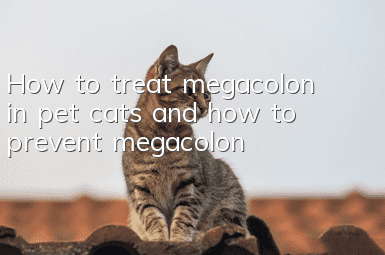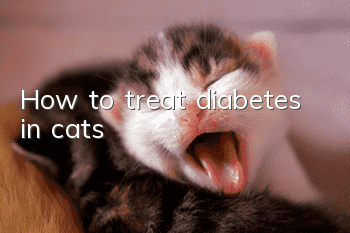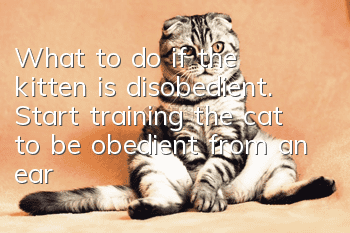How to treat megacolon in pet cats and how to prevent megacolon?

1. Introduction to megacolon
Megacolon is a common intestinal disease in cats. It is usually the result of long-term chronic constipation. In some cats, megacolon is congenital. The disease is caused by colonic smooth muscle dysfunction or colonic nerve damage.
This disease refers to the thickening of the colon and the hardness and dryness of the feces, resulting in megacolon. The stool in the colon becomes longer and longer and contains less and less water, causing the stool to become harder and harder. Dry stool makes it increasingly difficult to have a bowel movement, eventually leading to the inability to have a bowel movement.
The direct cause of megacolon is colon dysfunction, and the underlying causes of colon nerve damage or muscle disorder are changing. May be congenital, traumatic or uncertain. Old cats are most likely to develop megacolon, but young cats as young as three or four years old may also develop megacolon. The incidence rate is higher in male cats than in female cats.
The most common symptom of feline megacolon is chronic constipation. Cats may also show poor appetite, distended or swollen abdomen, nausea, vomiting, pain during defecation, severe rectal exstrophy during defecation, blood or mucus secretions during defecation, and a small amount of hard and small feces.
2. Treatment methods
During the initial treatment, there are many methods to treat feline megacolon, mainly to restore colon function and prevent the disease from becoming more serious. Medications are used to soften the stool and restore normal intestinal smooth muscle motility. Severe cases of megacolon may require medication and infusion treatment. If stool still cannot be passed, surgery or a fecal enema may be needed.
3. Case Analysis
1. Diagnosis
This is a case of megacolon in a 2-month-old kitten. The cat was adopted one month ago and had problems with defecation on and off until one month after the adoption, she discovered that her belly was very large. When she went to a local clinic for an examination, she found that the entire colon was severely colonized. Feces, expansion, and megacolon have formed. Due to the accumulation of feces in the colon, my appetite has been poor recently, resulting in weight loss, anemia, and a hematocrit of 18%. Palpation of the abdomen showed that the fecal mass in the colon was very hard. Obviously, this fecal mass could not be removed by conventional methods such as enema and other conservative methods. The anus and intestinal tissues of kittens are very "tender". If enema and feces are clamped with relatively "rough" actions, it can easily cause anal damage and intestinal rupture. After weighing the pros and cons, the decision was made to perform surgery. The problems of dehydration and anemia should be solved first before surgery. A cat weighing 460g will only need 12ml of whole blood to increase its blood volume to more than 30%. However, the blood matching work before blood transfusion is still indispensable. Let me add something about cat blood transfusion. The blood type of most cats is type A blood. However, even cats with the same blood type cannot be directly transfused. They still need to perform primary/lateral cross-matching before transfusion.Blood, usually three blood donor cats are matched, and one of them will always match.
2. Surgical plan
It was initially determined to be megacolon resection. However, when the abdominal cavity is opened and the feces in the colon are removed, because the cat is too young, removal of the colon means prolonged anesthesia and operation time, and increased bleeding, which may be fatal for such a thin cat. After careful consideration, it was decided to resect only part of the enlarged colon longitudinally, and the surgical plan was changed to colostomy. Even if megacolon develops again in the future, he will have to wait until his physical condition has recovered to the same level, including his body size, before considering a colectomy. After the operation, the cat quickly regained his energy and appetite, and his weight dropped to 240g after the operation, which means that the feces in his body accounted for almost half of his weight before the operation.
4. Prevention of Hirschsprung disease
It is better to prevent the disease than to cure it. The best way to prevent megacolon in cats is to take effective preventive measures to prevent the onset of megacolon. Preventive measures include maintaining your cat's ideal weight, as obesity is a risk factor for constipation. The diet should include fiber-rich foods and hair ball prevention should be done regularly. Groom the cat frequently to prevent the cat from developing hairballs, keep the litter box clean to ensure the cat defecates normally and prevent the cat from deliberately not defecating.
Usually at home, we can feed the cat something with high absorption and low residue, or feed the cat an appropriate amount of goat milk to promote digestion and absorption.
- What to do if a male cat in heat urinates everywhere
- What causes yellow urine in cats
- Can I deworm my cat again if there are still fleas after deworming?
- What common genetic diseases in cats do you know?
- What should I do if my cat with folded ears has diarrhea? What are the causes of diarrhea in folded-eared cats?
- Reasons why cats grind their claws and how to train cats to grind their claws in a fixed place
- Cat sneezing smells very bad
- Do cats get bored at home?
- How to clean blue cat’s ears
- Cat nipple inflammation



